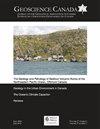努纳武特贝尔彻群岛的古新生代岩石:贝尔彻群岛古生代岩石:回顾其卓越的地质学及其与因纽特人主导的保护工作的相关性
IF 1.8
4区 地球科学
Q3 GEOSCIENCES, MULTIDISCIPLINARY
引用次数: 0
摘要
古新生代贝尔彻群(约 2.0 至 1.83 Ga)位于加拿大努纳武特地区哈德逊湾偏远的贝尔彻群岛。它包括近九公里长的保存完好的硅质碎屑岩和碳酸盐沉积岩,最初沉积于边缘到浅海环境中,代表了原加拿大地盾最早的真正大陆架环境之一。贝尔彻组存在多种沉积面,尤其以白云石中壮观的叠层石而闻名。除了这些宏观特征外,其中两个地层(Kasegalik 和 McLeary)还含有完整的 Eoentophysalis belcherensis 微化石,这是地质记录中已知最古老的蓝藻。贝尔彻组的最上部包含性质迥异的沉积岩,代表了一个较年轻的前陆盆地,该盆地是在跨哈德逊造山带的增生和碰撞过程中形成的。这些较年轻的地层(奥马鲁鲁克地层和 Loaf 地层)由厚厚的浊积岩组成,上面覆盖着水成岩和其他未成熟的碎屑沉积岩。奥马鲁鲁克地层的一个显著特点是存在钙质凝块。奥马鲁鲁克地层与 "omars "具有相同的特征,"omars "是冰川搬运的碎屑,出现在加拿大部分地区和美国北部更远的地方,有助于描述整个大陆的更新世冰流趋势。 贝尔彻组还包括两个以壮观的岩浆火山岩为主的地层。以爱斯基摩地层为代表的早期火山岩反映的主要是海下火山流的喷发,被解释为与大陆架形成过程中阿新世基底断裂有关的洪积玄武岩。后来的火山活动(弗拉赫蒂地层)以海底枕状玄武岩流为主,并被归入不同的构造环境,包括与俯冲有关的火山弧,以及与地幔羽流活动和大陆边缘新的断裂有关的大洋高原。后来的火山活动标志着大陆架向前陆盆地的过渡。在贝尔彻群的中下部出现了岩浆岩和相关的侵入体(海格侵入体)。黑云母岩浆和钙质页岩之间的热力和化学作用产生了不寻常的岩石,这些岩石在努纳武特地区作为优质的手工雕刻石材而闻名。贝尔彻群还包含过去曾引起勘探兴趣的上等铁矿层。 贝尔彻群是一个独特的地质实体,其岩石类型多种多样,出露程度极高,并有可能展示地球历史形成时期的许多重要地质过程。它也是独特的古生物微化石资源,其沉积括起了前寒武纪大气和海洋演化的一个关键和备受争议的时期。它是了解这些变化的重要科学资源。本综述文件重点介绍了其最重要的特征,讨论了其未来研究的潜力,并有助于更广泛地讨论其作为努纳武特地区保护区未来可能发挥的作用。本文章由计算机程序翻译,如有差异,请以英文原文为准。
Paleoproterozoic Rocks of the Belcher Islands, Nunavut: A Review of Their Remarkable Geology and Relevance to Inuit-led Conservation Efforts
The Paleoproterozoic Belcher Group (ca. 2.0 to 1.83 Ga) occurs on the remote Belcher Islands of Hudson Bay in Nunavut, Canada. It includes nearly nine kilometres of well-preserved siliciclastic and carbonate sedimentary rocks, deposited initially in a marginal to shallow marine setting representing one of the first true continental shelf environments on the proto-Canadian Shield. A wide variety of depositional facies exists within the Belcher Group, and it is particularly well known for its spectacular stromatolites in dolostone. In addition to these macroscopic features, two of its formations (Kasegalik and McLeary) contain intact microfossils of Eoentophysalis belcherensis, the oldest known occurrence of cyanobacteria in the geological record. The uppermost part of the Belcher Group contains sedimentary rocks of very different character that represent a younger foreland basin that developed in response to accretionary and collisional processes of the Trans-Hudson orogen. These younger formations (Omarolluk and Loaf) consist of a thick sequence of turbidites, overlain by arkose and other immature clastic sedimentary rocks. A defining characteristic of the Omarolluk Formation is the presence of calcareous concretions. The Omarolluk Formation shares attributes with “omars”, which are glacially transported clasts that occur both locally and further afield throughout parts of Canada and the northern United States and have helped characterize Pleistocene ice-flow trends across the continent. The Belcher Group also includes two formations dominated by spectacular mafic volcanic rocks. The earlier episode, represented by the Eskimo Formation, reflects eruption of largely subaerial volcanic flows interpreted to represent flood basalt associated with the rifting of Archean basement during the establishment of the continental shelf. A later volcanic episode (the Flaherty Formation) is dominated by submarine pillowed basalt flows and has been assigned to varied tectonic settings, including volcanic arcs related to subduction and oceanic plateaus related to mantle plume activity and renewed rifting along the continental margin. This later volcanism marks the transition from shelf to foreland basin. Mafic sills and related intrusions (Haig intrusions) occur in the middle and lower part of the Belcher Group. Thermal and chemical interactions between mafic magma and calcareous shale generated unusual rocks that are well known in Nunavut as high-quality artisanal carving stone. The Belcher Group also contains Superior-type iron formations that have attracted past exploration interest. The Belcher Group is a unique geological entity defined by its wide variety of rock types, its superb exposures, and its potential to illustrate many important geological processes in a formative time in Earth’s history. It is also a unique microfossil paleontological resource, and its deposition brackets a crucial and much-debated interval of Precambrian atmospheric and oceanic evolution. It represents an important scientific resource in the context of understanding such changes. This general review paper highlights its most important features, discusses its potential for future research and contributes to wider discussions about its possible future role as a protected area within Nunavut.
求助全文
通过发布文献求助,成功后即可免费获取论文全文。
去求助
来源期刊

Geoscience Canada
地学-地球科学综合
CiteScore
3.30
自引率
0.00%
发文量
9
审稿时长
>12 weeks
期刊介绍:
Established in 1974, Geoscience Canada is the main technical publication of the Geological Association of Canada (GAC). We are a quarterly journal that emphasizes diversity of material, and also the presentation of informative technical articles that can be understood not only by specialist research workers, but by non-specialists in other branches of the Earth Sciences. We aim to be a journal that you want to read, and which will leave you better informed, rather than more confused.
 求助内容:
求助内容: 应助结果提醒方式:
应助结果提醒方式:


